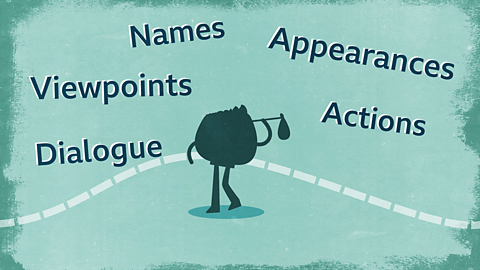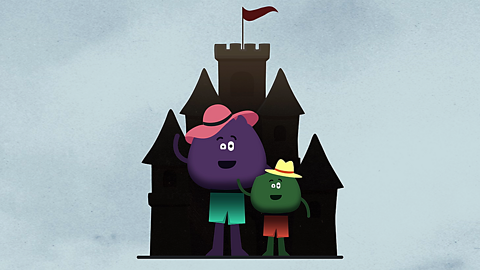What do you know?
What links Suzanne Collins‚Äô The Hunger Games and ≥ß≥Û≤π∞ϱ≤ı±Ë±≤π∞˘±‚Äôs Macbeth?
Even though they were written 400 years apart on different continents, they both share the same theme: the misuse of power.
Introduction to themes
Key learning points
Have you ever wondered what it means when we talk about the ‘theme’ in a fiction text?
In literature, theme is a word used to talk about the ‘big ideas’. This is different to the plot, which is what happens in the story.For example, the plot of JK Rowling's’ Harry Potter series tells how a young boy discovers that he is a wizard. The book also explores bigger ideas, or themes, such as good versus evil and the importance of friendship.
Video about theme
A video covering different themes, examples of themes and how to identify the themes in fiction writing
Themes are the main ideas or meaning that run through a text. Themes are often universal ideas or experiences and the same themes can be presented differently in different stories.
John Steinbeck’s Of Mice and Men presents themes of poverty, masculinity, discrimination and friendship.
Emily Brontë’s Wuthering Heights explores themes of romantic love, isolation, grief and the power of nature.
David Almond’s Skellig includes themes like caring, friendship, trust and love.
You could say that a theme is the idea that a text is really about. It’s what lies beneath the surface. You can identify themes by looking for repeated images, motifs or ideas.
≥ß≥Û≤π∞ϱ≤ı±Ë±≤π∞˘±‚Äôs Macbeth tells the story of a man who kills his king so he can take the throne. Some of the themes explored through that story are ambition, fate and appearance versus reality.
Let’s explore one of those ideas – that things are not always what they seem. Appearances can be different from reality. For example, Macbeth and his wife welcome King Duncan into their home as an honoured guest. They appear to be warm, welcoming and friendly, but in reality, Duncan will not last the night.
Throughout the play there is a use of double meanings and twisted language. The witches’ predictions, which drive Macbeth to murder, do not mean what Macbeth assumes.
Think about themes when you’re reading a text and explore how the writer has used themes to articulate an idea that a text is really about.
What is a theme?
When you are reading, think about the big ideas that are connected to the story. Is it a story about love? Is it about family? Perhaps it is about forgiveness? These are all examples of themes.
Consider what you might say to someone who asked ‘what is the book about?’ without telling them what happens in the book. Your answer will probably be one of the themes of the book.
For example, if you didn’t want to ruin the plot of Markus Zusak’s The Book Thief, you might tell someone that it is a book about death, friendship and war, as these are three of the story’s themes.
Remember:
- The plot is what happens in the story
- The themes are the big universal ideas explored within the story
- A story can have more than one theme
Common themes in literature
Themes might be shared by very different books and writers might suggest different things about their themes, or just ask questions about these big ideas. Common themes include:
- love
- death
- time
- humans vs nature
- politics
Click on these images of common literary themes to see examples of works in which they appear.
Themes and motifs
Writers don’t directly name their themes. Instead, the reader has to pick up on the clues they give us and think about the big ideas that they are exploring in their writing so that we can find out the theme or themes.
One way in which writers can give these clues about theme is to use symbols and motifs.
- Symbols are objects or images that represent something else. For example in Suzanne Collins’ The Hunger Games, the mockingjay is a symbol of rebellion.
- Motifs are collections of symbols which are used repeatedly in a story. In The Hunger Games Mockingjay is the name given to the character Katniss, a badge that she wears, and the gesture used to identify members of the rebellion. Through repeated use it becomes a recurring motif.
Motifs are usually easier to spot, as they are repeated in the text. A motif is just the name for symbols which are repeated. For example, in ≥ß≥Û≤π∞ϱ≤ı±Ë±≤π∞˘±‚Äôs play Hamlet there are repeated images of sickness which symbolise the corruption and ‚Äòillness‚Äô in the society of the play. Shakespeare used the motif of sickness to represent the theme of corruption in the play.
Think about what the symbol or motif represents to work out what larger theme is being suggested.
How to trace a theme through a text
You can start to trace a theme through a text by:
- looking for repeated symbols and motifs
- thinking about what these symbols might represent
- asking yourself what big ideas the writer might be drawing the reader’s attention to through this repetition
If this gives you a big idea, and not just the plot of the story, you might have identified a theme of the text.
Remember that many texts have multiple themes. There’s no definite list of the themes in any text. If you think an author is exploring an idea, and you can find some evidence in the text to show why you think this, then you’re probably right.
How themes are evident in characters, plot and setting
A reader can also get clues about the theme from looking at:
- Characters
How do they change and grow? What do they learn during the story? For example, in Stephen Chbosky’s The Perks of Being a Wallflower, the main character develops from being alone to having a group of close friends, which makes him happier. This suggests that one of the themes of the story is the importance of friendship. - Plot
What are the important moments in the story? Do these moments have anything in common? For example, in Mary Shelley’s Frankenstein, Victor Frankenstein works hard to create his creature, but is shocked when it comes to life. This moment suggests that one of the themes is the dangers of going beyond human limits. - Setting
When and where is the story set? How much of the story is specific to this setting and how much is universal (applies more widely)? For example, Robert Frost’s poem The Road Not Taken is set at a fork in the road. From this, we can guess that one of the themes might be about making decisions as we ‘journey’ through life.
Remember: try to answer ‘what is the story about?’ without just retelling the plot. This is likely to help you identify the theme.
Use the interactive graphic below to understand how theme can be determined from plot, setting and character.
Test your knowledge
Play Bitesize secondary games. gamePlay Bitesize secondary games
Have fun playing science, maths, history, geography and language games.

More on Critical reading
Find out more by working through a topic
- count3 of 11

- count4 of 11

- count5 of 11

- count6 of 11
